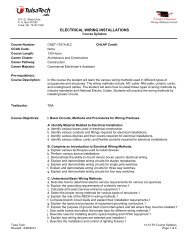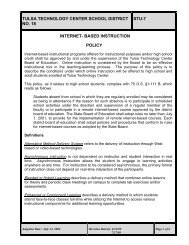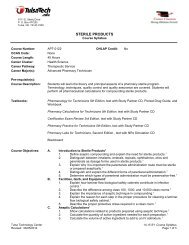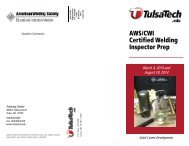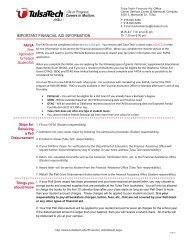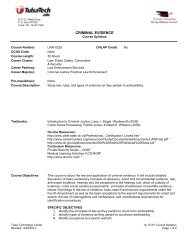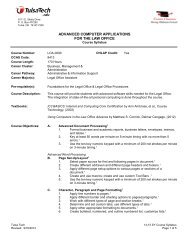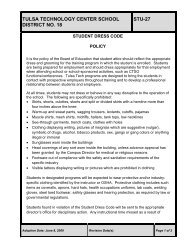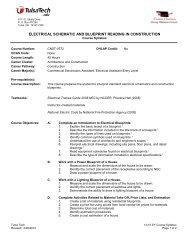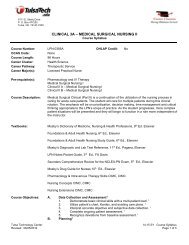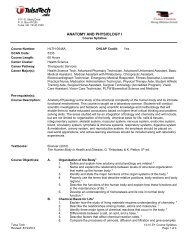Motor Control Wiring in Construction - Tulsa Technology Center
Motor Control Wiring in Construction - Tulsa Technology Center
Motor Control Wiring in Construction - Tulsa Technology Center
You also want an ePaper? Increase the reach of your titles
YUMPU automatically turns print PDFs into web optimized ePapers that Google loves.
6111 E. Skelly Drive<br />
P. O. Box 477200<br />
<strong>Tulsa</strong>, OK 74147-7200<br />
MOTOR CONTROL WIRING IN CONSTRUCTION<br />
Course Syllabus<br />
Course Number: CNST-0207 OHLAP Credit: No<br />
OCAS Code:<br />
None<br />
Course Length: 30 Hours<br />
Career Cluster: Architecture and <strong>Construction</strong><br />
Career Pathway: <strong>Construction</strong><br />
Career Major(s): Commercial Electrician’s Assistant<br />
Pre-requisite(s):<br />
Course Description:<br />
This course covers relays, motor starters, overload siz<strong>in</strong>g, ladder diagrams, and design of<br />
complex systems used to control motors <strong>in</strong> various commercial and <strong>in</strong>dustrial applications.<br />
Textbooks:<br />
Amatrol Electrical Tra<strong>in</strong><strong>in</strong>g Systems<br />
Electrical Tra<strong>in</strong>ee Guide 2008 NEC by NCCER, Prentice Hall (2008)<br />
Course Objectives: A. Work with Contactors and Relays.<br />
1. Describe the operat<strong>in</strong>g pr<strong>in</strong>ciples of contactors and relays. 2<br />
2. Select contactors and relays for use <strong>in</strong> specific electrical systems. 2<br />
3. Expla<strong>in</strong> how mechanical contactors operate. 2<br />
4. Expla<strong>in</strong> how solid-state contactors operate. 2<br />
5. Install contactors and relays accord<strong>in</strong>g to the NEC® requirements. 2<br />
6. Select and <strong>in</strong>stall contactors and relays for light<strong>in</strong>g control. 2<br />
7. Read wir<strong>in</strong>g diagrams <strong>in</strong>volv<strong>in</strong>g contactors and relays. 2<br />
8. Describe how overload relays operate. 2<br />
9. Connect a simple control circuit.<br />
10. Test control circuits. 2<br />
B. Install and Operate Circuits Us<strong>in</strong>g <strong>Control</strong> Logic.<br />
1. Describe the function of relay control logic circuits. 1<br />
2. List the six elements of control logic. 1<br />
3. Describe the function of AND logic and give an application. 1<br />
4. Connect and operate an AND control logic circuit. 1<br />
5. Describe the function of OR logic and give an application. 1<br />
6. Connect and operate an OR logic control circuit. 1<br />
7. Describe the function of NOT logic and give an application. 1<br />
8. Connect and operate a NOT logic control circuit. 1<br />
9. Describe the function of NOR logic and give an application. 1<br />
10. Connect and operate a NOR logic control circuit. 1<br />
11. Describe the function of NAND logic and give an application. 1<br />
12. Connect and operate a NAND logic control circuit. 1<br />
13. Describe the function of a MEMORY logic and give an application. 1<br />
14. Describe the function of a ladder diagram. 1<br />
15. Identify the four basic components of a ladder diagram. 1<br />
16. Describe the function of the four components of a ladder diagram. 1<br />
<strong>Tulsa</strong> Tech<br />
14-15 SY Course Syllabus<br />
Revised: 8/27/2014 Page 1 of 3
MOTOR CONTROL WIRING IN CONSTRUCTION<br />
17. Expla<strong>in</strong> five rules of draw<strong>in</strong>g a ladder diagram. 1<br />
18. Read and <strong>in</strong>terpret the operation of a circuit given a ladder diagram. 1<br />
19. Connect and operate a logic circuit given a ladder diagram. 1<br />
20. Design and ladder diagram us<strong>in</strong>g one or more logic elements. 1<br />
21. Describe the function of a solenoid operated fluid power valve. 1<br />
22. Describe the function of a power diagram. 1<br />
23. Connect and operate a circuit us<strong>in</strong>g a solenoid valve given a ladder diagram. 1<br />
24. Design a control circuit <strong>in</strong> a ladder diagram format to operate a solenoid valve. 1<br />
C. Install and Operate Circuits Us<strong>in</strong>g Sequenc<strong>in</strong>g <strong>Control</strong>.<br />
1. Describe the function of an electromechanical relay and give an application.<br />
2. Describe the operation of an electromechanical relay and give its ladder<br />
diagram symbol.<br />
3. Read and <strong>in</strong>terpret a basic ladder diagram with detached symbology.<br />
4. Describe the operation of a relay used to energize a fluid power valve solenoid.<br />
5. Connect and operate a relay to energize a fluid power solenoid.<br />
6. Describe the operation of a relay perform<strong>in</strong>g control logic.<br />
7. Design a logic circuit that uses a relay.<br />
8. Describe the function and operation of a seal-<strong>in</strong> circuit.<br />
9. Connect and operate a relay to perform a seal-<strong>in</strong> function.<br />
10. Describe the function of a limit switch and give an application.<br />
11. Describe the operation of a limit switch and give its schematic symbol.<br />
12. Describe the operation of a limit switch <strong>in</strong> an event sequenc<strong>in</strong>g circuit.<br />
13. Connect and operate an event sequenc<strong>in</strong>g circuit given a ladder diagram.<br />
14. Design a logic circuit that uses a limit switch to sequence an event.<br />
15. Describe the operation of a limit switch <strong>in</strong> a s<strong>in</strong>gle-cycle cyl<strong>in</strong>der reciprocation.<br />
16. Connect and operate a cont<strong>in</strong>uous-cycle reciprocation circuit.<br />
17. Describe the operation of a limit switch <strong>in</strong> an event de-energiz<strong>in</strong>g circuit.<br />
18. Describe the operation of a limit switch <strong>in</strong> a cont<strong>in</strong>uous-cycle reciprocation<br />
circuit.<br />
19. Connect and operate cont<strong>in</strong>uous-cycle cyl<strong>in</strong>der reciprocation circuit.<br />
20. Describe the operation of a safety <strong>in</strong>terlock circuit.<br />
21. Design a cont<strong>in</strong>uous-cycle cyl<strong>in</strong>der reciprocation circuit with a safety <strong>in</strong>terlock.<br />
D. Install, Connect and Operate Timers and Relay Systems<br />
1. Connect and operate a control circuit with a timer relay.<br />
2. Design a time-driven traffic light circuit.<br />
3. Connect and operate a control circuit to perform an unloaded start of a motor.<br />
4. Design a control circuit to perform a cyl<strong>in</strong>der dwell.<br />
5. Design a control circuit to perform time-driven sequenc<strong>in</strong>g.<br />
6. Design a dual cyl<strong>in</strong>der sequence circuit us<strong>in</strong>g one limit switch.<br />
7. Connect and operate a dual-cyl<strong>in</strong>der control circuit us<strong>in</strong>g two limit switches.<br />
8. Design a cont<strong>in</strong>uous-cycle multiple-cyl<strong>in</strong>der circuit.<br />
9. Connect and operate a circuit hav<strong>in</strong>g both automatic and manual modes of<br />
operation.<br />
10. Connect and operate a control circuit to simulate a two-pushbutton jog circuit.<br />
11. Connect and operate a two-pushbutton jog circuit that will jog two cyl<strong>in</strong>ders<br />
<strong>in</strong>dependently.<br />
12. Design a cont<strong>in</strong>uous cycle, synchronized cyl<strong>in</strong>der circuit with a manual mode.<br />
E. Install Various <strong>Motor</strong> <strong>Control</strong> Circuits Us<strong>in</strong>g Industrial Equipment and Materials<br />
to Perform <strong>Motor</strong> Operations.<br />
1. Draw various motor control circuits to perform motor operations.<br />
2. Connect and operate the follow<strong>in</strong>g motor control circuits.<br />
<strong>Tulsa</strong> Tech<br />
14-15 SY Course Syllabus<br />
Revised: 8/27/2014 Page 2 of 3
MOTOR CONTROL WIRING IN CONSTRUCTION<br />
a. One Start Stop<br />
b. Two Start Stop<br />
c. Three Start Stop<br />
d. Jog <strong>Control</strong><br />
e. Forward and Revers<strong>in</strong>g <strong>Motor</strong> <strong>Control</strong>ler<br />
3. Install motors to operate from motor controllers.<br />
4. Test and troubleshoot various motor control circuits.<br />
1<br />
Amatrol objective<br />
2<br />
NCCER objective<br />
All unmarked objectives are TTC <strong>in</strong>structor developed.<br />
Teach<strong>in</strong>g Methods:<br />
The class will primarily be taught by the lecture and demonstration method and supported by<br />
various media materials to address various learn<strong>in</strong>g styles. There will be question and answer<br />
sessions over material covered <strong>in</strong> lecture and media presentations. Supervised lab time is<br />
provided for students to complete required projects.<br />
Grad<strong>in</strong>g Procedures:<br />
1. Students are graded on theory and shop practice and performance.<br />
2. Each course must be passed with seventy (70%) percent or better.<br />
3. Grad<strong>in</strong>g scale: A=90-100%, B=80-89%, C=70-79%, D=60-69%, F=50-59%.<br />
Description of<br />
Classroom,<br />
Laboratories, and<br />
Equipment:<br />
<strong>Tulsa</strong> <strong>Technology</strong> <strong>Center</strong> campuses are owned and operated by <strong>Tulsa</strong> <strong>Technology</strong> <strong>Center</strong><br />
School District No. 18. All programs provide students the opportunity to work with<br />
professionally certified <strong>in</strong>structors <strong>in</strong> modern, well-equipped facilities.<br />
Available<br />
Certifications/<br />
College Credit<br />
The student may be eligible to take state, national or <strong>in</strong>dustry exam after completion of the<br />
program. College credit may be issued from Oklahoma State University-Okmulgee or <strong>Tulsa</strong><br />
Community College. See program counselor for additional <strong>in</strong>formation.<br />
College Credit<br />
Eligibility:<br />
The student must ma<strong>in</strong>ta<strong>in</strong> a grade po<strong>in</strong>t average of 2.0 or better.<br />
<strong>Tulsa</strong> Tech<br />
14-15 SY Course Syllabus<br />
Revised: 8/27/2014 Page 3 of 3



